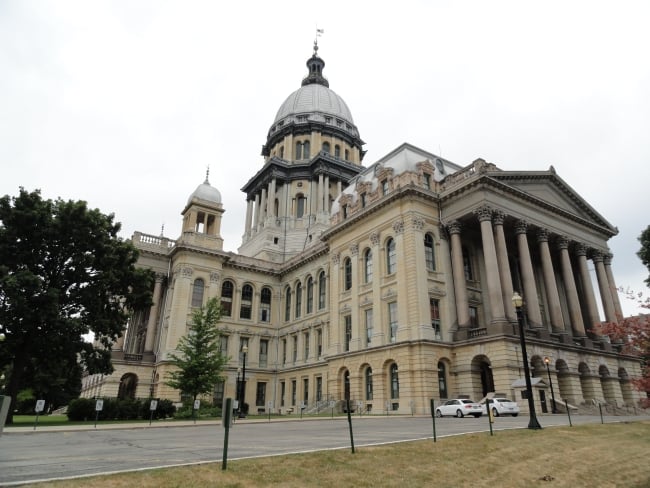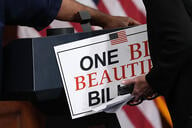You have /5 articles left.
Sign up for a free account or log in.

Illinois State Capitol
Wikimedia Commons
Some universities in Illinois don’t know how they’re going to make payroll in a few months if the state’s politicians don’t pass a budget soon.
Now halfway through the fiscal year, Illinois’s Legislature and governor still have not agreed on a 2015-16 budget, forcing countless agencies and services -- including the state’s multibillion-dollar public higher education sector -- to find ways to fund operating costs and scholarships that would otherwise be covered by the state.
As a result, universities are dipping into reserves, laying off faculty members and even considering borrowing against future state appropriations to cover costs while they wait for a state budget. Officials characterize the landscape as a desperate one.
“We are making ourselves limp through month to month,” says Randy Dunn, president of the Southern Illinois University System, which has two campuses with a combined enrollment of about 31,000. SIU was expecting roughly $200 million in state appropriations this year, along with $18-20 million in funding to cover Monetary Award Program (MAP) grants, which are state-funded grants for low-income students.
In the summer, as the governor and Legislature were debating the budget (at the time, Republican Governor Bruce Rauner proposed a 31.5 percent cut to higher education, which the Legislature wanted to reduce to about 8.6 percent), Dunn never suspected Illinois would go into 2016 without a ratified budget. Even now, he and other university officials in the state aren’t sure when the governor and Legislature will successfully negotiate a new budget. Some who are optimistic are hoping for this month, but others predict that it will be sometime after the March primary elections. Those with the grimmest of outlooks are worried the state will skip setting the budget this year entirely and instead pass a two-year 2015-17 budget in the spring.
Meanwhile, universities are making drastic adjustments as more and more time lapses without state funds.
SIU has borrowed against several reserve funds, heavily reduced administrative and discretionary spending, laid off about 25 employees and eliminated or left vacant another 50 positions. The university has stopped operating programs -- such as research programs and training programs -- that were funded by state grants but are no longer solvent because the state money has dried up and isn’t getting replaced. It’s covering the cost of MAP grants for about 7,700 students (the grants can reach $5,000 per student each year), but is warning recipients -- all of whom are low income -- that if the state doesn’t fund the grants, they may well be on the hook for the money.
“We’re seeing this incremental dismantling of our universities piece by piece, as people get laid off and things get shut down,” said Dunn. “Over time you turn around and you wonder what happened to your university. Piece by piece it just disappeared on you. I worry that we started down that path.”
Dunn said the state’s public universities are “hostages” to the political infighting in Springfield. There’s concern that even when the state does pass a budget, it will have lost too much time to generate enough revenue to fully fund it, and as a consequence higher education -- one of the state's largest discretionary expenses -- will be left in the lurch. It doesn’t help that, after high-profile scandals at the College of DuPage and the University of Illinois, higher education has been in a spotlight of late, with many state politicians criticizing the leadership and spending of public institutions.
“If you look at it from the public’s point of view … nobody closed, everybody [with MAP grants] has been able to go to school and employees have gotten paid, so there’s been no crisis,” he said. “Are we going to be left holding the bag? … A lot of us … are very nervous.”
Western Illinois University has spent much of its general reserves and is now borrowing from reserve funds that were never expected to be used for operating costs -- like transportation funds that were earmarked for a new parking lot or health center funds set aside for a specific purpose. The result is that some areas of the university are having to delay projects, even though those areas do not depend on state funding.
“When we’re robbing Peter to pay Paul here on campus because the state is not meeting their responsibilities, it will have far-reaching implications for many of our operations,” said Matt Bierman, WIU’s budget director.
The University of Illinois System has an administrative hiring freeze in place while it awaits state funding. This year the system expected to get $62 million in MAP grant funding from the state. Its appropriations last year were $660 million. Like other universities in the state, the system is spending down reserves, reducing spending and looking for operational efficiencies as it goes into a second semester without state funding, according to a spokesman.
Similar Woes in Pennsylvania
Pennsylvania colleges and universities faced similar struggles as the state's Democratic governor and Republican Legislature sparred over the fiscal 2016 budget. Institutions had to dip into their own coffers to temporarily cover millions in state funding during the budget standoff.
But in late December the governor approved a stopgap budget that keeps funding level for Pennsylvania's state-owned universities and community colleges (three state-related universities continue to wait for a budget) and approved funding for state-supported student grants, although at levels lower than originally projected.
Yet as they await state funds, some Pennsylvania colleges have struggled financially. The Community College of Allegheny County and Butler County Community College, for example, ended up borrowing millions to cover operational costs and meet payroll, according to a report by the Pittsburgh Post-Gazette.
Meanwhile, many universities in the state are facing struggles on multiple fronts, and not just because of the budget impasse. Moody’s credit rating agency downgraded six Illinois colleges and universities in the fall, including Northern Illinois University, Eastern Illinois University, WIU and SIU. And several universities are experiencing enrollment declines that are further restricting revenue. SIU’s Carbondale campus, for example, saw a 4 percent enrollment drop this year, which created a revenue shortfall upward of $5 million.
WIU, in response to years of slowly reducing appropriations and enrollment declines (the university's enrollment has dipped from roughly 13,000 students in 2006 to 11,100 students this fall), offered early retirement incentives to nearly 60 employees and plans to lay off around 50 faculty members in the near future. It has also begun exploring cutting academic programs with low enrollment. In the summer, EIU also announced layoffs.
Chicago State University, a minority-majority institution with enrollment of about 4,800 students, was set to receive $36 million in state appropriations this year (about 30 percent of its operating budget), another $5 million in MAP grant funding and $1.6 million in state-funded merit scholarships. Yet like its peers elsewhere in the state, it hasn’t received a single dollar in state funding for those items this year.
The university is far from flush, and the budget crisis has forced it to dip into reserves and lay off about 15 percent of its administrative staff. Tom Wogan, director for public relations and government affairs, says Chicago State is considering drastic measures to stay afloat.
“At some point we’re not going to be able to meet payroll and function as a university,” he said. So the university is lobbying for an interim solution -- perhaps an emergency bill that would provide a portion, but not all, of appropriations, or a legislative measure that would allow Chicago State to take the risky move of borrowing against future appropriations.
“We’re getting through week by week, but that is by burning through cash reserves that we previously were relying on for financial security,” he continued. If there’s no budget agreement soon, “not only will we reach a point where the university can’t function, but where the university can’t function and does not have cash reserves, which is a very dangerous place to be.”
Roughly 130,000 students throughout Illinois receive MAP grants, and about 40,000 of them attend private institutions. Most colleges are temporarily covering the cost of the grant for students -- but it’s a financial stretch for many. For some private universities with large in-state student populations, the price tag for covering the MAP grants, even if it’s a temporary cost, is high.
For example, covering MAP grants for the year has cost DePaul University in Chicago about $17 million. At least one private college, the Illinois Institute of Technology, had to deny students MAP funding for the spring semester because it was uncertain it could cover the costs and remain financially solvent. Additionally, some community colleges aren’t funding the grants, either. The result, officials say, is devastating for socioeconomic and racial diversity. (The Illinois Senate did pass a bill that would have funded MAP grants, but the measure has not passed the House of Representatives.)
“You’re picking on the most vulnerable students … it’s just kind of insanity. No one understands it,” said David Tretter, head of the Federation of Independent Illinois Colleges and Universities.
“None of us have seen anything like this,” he continued. “The colleges have done everything they can to still enroll the students who are eligible for MAP, but it amounts to a number of problems [that are] highlighted at some of my smaller institutions that frankly don't have the resource to cash flow these students any longer.”
Jennifer Delaney, a professor of higher education at the University of Illinois, said the state is not honoring the commitment it made to low-income students when it offered them the MAP grants, and added that placing the burden of funding the grants, even temporarily, on universities is “taking advantage” of institutions that “have so much doubt about when, or if, that money will come through.”
“Most institutions are in some type of crisis management,” she said. “The uncertainty in itself is very trying for institutions.”
Bierman is very aware of the financial difficulties facing the state (Illinois has a broken pension system with a shortfall of $111 billion, as well as the worst credit rating of any state in the country), but said the state can't afford to stop investing in higher education.
“The state needs to get their act together and solve this, because higher education is part of the economic engine of this state,” he said. “We understand that may mean cuts, but we need predictable funding.”




